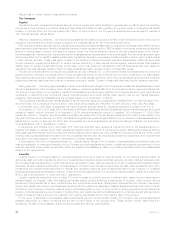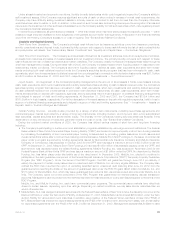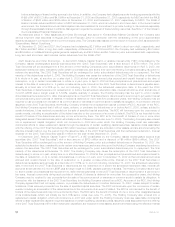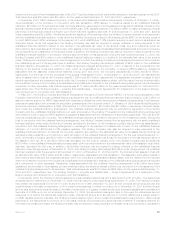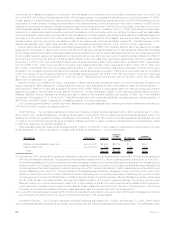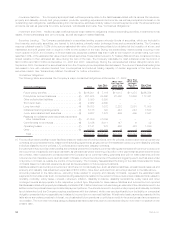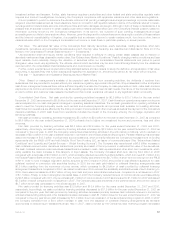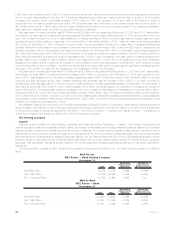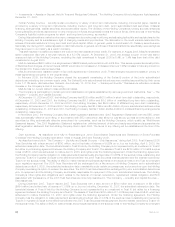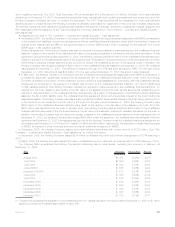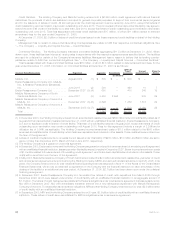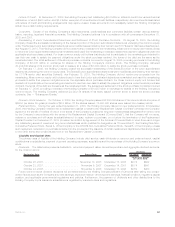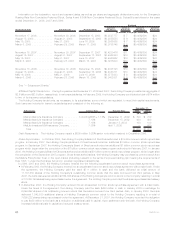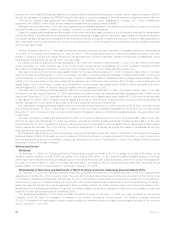MetLife 2008 Annual Report Download - page 59
Download and view the complete annual report
Please find page 59 of the 2008 MetLife annual report below. You can navigate through the pages in the report by either clicking on the pages listed below, or by using the keyword search tool below to find specific information within the annual report.financing arrangements, the Holding Company may be required to deliver cash or pledge collateral to the respective unaffiliated financial
institutions. See “Holding Company — Global Funding Sources.”
Junior subordinated debt securities bear interest at fixed interest rates through their respective redemption dates. Interest was computed
using the stated rates on the obligations through the scheduled redemption dates as it is the Company’s expectation that the debt will be
redeemed at that time. Inclusion of interest payments on junior subordinated debt through the final maturity dates would increase the
contractual obligation by $4.6 billion.
(5) The Company has accepted cash collateral in connection with securities lending and derivative transactions. As the securities lending
transactions expire within the next year or the timing of the return of the collateral is uncertain, the return of the collateral has been included
in the less than one year category in the table above. The Company also holds non-cash collateral, which is not reflected as a liability in the
consolidated balance sheet, of $1.2 billion at December 31, 2008.
(6) The Company commits to lend funds under mortgage loans, partnerships, bank credit facilities, bridge loans and private corporate bond
investments. In the table above, the timing of the funding of mortgage loans and private corporate bond investments is based on the
expiration date of the commitment. As it relates to commitments to lend funds to partnerships and under bank credit facilities, the
Company anticipates that these amounts could be invested any time over the next five years; however, as the timing of the fulfillment of the
obligation cannot be predicted, such obligations are presented in the less than one year category in the table above. Commitments to
fund bridge loans are short-term obligations and, as a result, are presented in the less than one year category in the table above. See
“— Off-Balance Sheet Arrangements.”
(7) As a lessee, the Company has various operating leases, primarily for office space. Contractual provisions exist that could increase or
accelerate those leases obligations presented, including various leases with early buyouts and/or escalation clauses. However, the
impact of any such transactions would not be material to the Company’s financial position or results of operations. See “— Off-Balance
Sheet Arrangements.”
(8) Other includes those other liability balances which represent contractual obligations, as well as other miscellaneous contractual
obligations of $12 million not included elsewhere in the table above. Other liabilities presented in the table above are principally
comprised of amounts due under reinsurance arrangements, payables related to securities purchased but not yet settled, securities sold
short, accrued interest on debt obligations, estimated fair value of derivative obligations, deferred compensation arrangements, guaranty
liabilities, the estimated fair value of forward stock purchase contracts, as well as general accruals and accounts payable due under
contractual obligations. If the timing of any of the other liabilities is sufficiently uncertain, the amounts are included within the less than one
year category.
The other liabilities presented in the table above differs from the amount presented in the consolidated balance sheet by $4.0 billion due
primarily to the exclusion of items such as minority interests, legal liabilities, pension and postretirement benefit obligations, taxes due
other than income tax, unrecognized tax benefits and related accrued interest, accrued severance and employee incentive compensation
and other liabilities such as deferred gains and losses. Such items have been excluded from the table above as they represent accounting
conventions or are not liabilities due under contractual obligations.
The net funded status of the Company’s pension and other postretirement liabilities included within other liabilities has been excluded
from the amounts presented in the table above. Rather, the amounts presented represent the discretionary contributions of $150 million to
be made by the Company to the pension plan in 2009 and the discretionary contributions of $120 million, based on the current year’s
expected gross benefit payments to participants, to be made by the Company to the postretirement benefit plans during 2009. Virtually all
contributions to the pension and postretirement benefit plans are made by the insurance subsidiaries of the Holding Company with little
impact on the Holding Company’s cash flows.
Excluded from the table above are unrecognized tax benefits and accrued interest of $766 million and $176 million, respectively, for which
the Company cannot reliably determine the timing of payment. Current income tax payable is also excluded from the table.
See also “— Off-Balance Sheet Arrangements.”
Separate account liabilities are excluded from the table above. Generally, the separate account owner, rather than the Company, bears
the investment risk of these funds. The separate account assets are legally segregated and are not subject to the claims that arise out of
any other business of the Company. Net deposits, net investment income and realized and unrealized capital gains and losses on the
separate accounts are fully offset by corresponding amounts credited to contractholders whose liability is reflected with the separate
account liabilities. Separate account liabilities are fully funded bycashflowsfromtheseparateaccount assets and are set equal to the
estimated fair value of separate account assets as prescribed by SOP 03-1.
The Company also enters into agreements to purchase goods and services in the normal course of business; however, these purchase
obligations are not material to its consolidated results of operations or financial position at December 31, 2008.
Additionally, the Company has agreements in place for services it conducts, generally at cost, between subsidiaries relating to
insurance, reinsurance, loans, and capitalization. Intercompany transactions have appropriately been eliminated in consolidation. Inter-
company transactions among insurance subsidiaries and affiliates have been approved by the appropriate departments of insurance as
required.
Support Agreements. The Holding Company and several of its subsidiaries (each, an “Obligor”) are parties to various capital support
commitments, guarantees and contingent reinsurance agreements with certain subsidiaries of the Holding Company and a corporation in
which the Holding Company owns 50% of the equity. Under these arrangements, each Obligor, with respect to the applicable entity, has
agreed to cause such entity to meet specified capital and surplus levels, has guaranteed certain contractual obligations or has agreed to
provide, upon the occurrence of certain contingencies, reinsurance for such entity’s insurance liabilities. Management anticipates that to
the extent that these arrangements place significant demands upon the Company, there will be sufficient liquidity and capital to enable the
Company to meet these demands. See “The Holding Company — Liquidity and Capital Uses — Support Agreements.”
Litigation. Putative or certified class action litigation and other litigation, and claims and assessments against the Company, in addition
to those discussed elsewhere herein and those otherwise provided for in the Company’s consolidated financial statements, have arisen in
the course of the Company’s business, including, but not limited to, in connection with its activities as an insurer, employer, investor,
56 MetLife, Inc.




